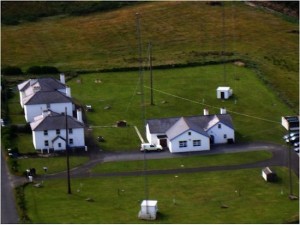Malin Head Coastguard Station has already recorded its busiest year in its history.
The Inishowen station co-ordinated its 500th incident on Wednesday, September 25th.
The station responds to calls and helps other rescue missions from around the globe as it monitors radio alerts between boats.
The station is 111 years old although a lot has changed in that time.
Below is a history of the station courtesy of the Malin Head Radio coastguard.
Keep up the great work guys!
Malin Head Radio celebrated 100 years of service in January 2002!!!
Ireland’s most northerly point has had a long history of communication with ships. In 1805, Lloyds built a signal tower at a point now called Banba’s Crown. The building still stands, though now in a ruined condition. Today there is a viewing area and visitors car park next to this historic site. Semaphore and a telescope were the methods used to communicate with ships and to the island of Inishtrahull, some six miles away where another Lloyds signal station was erected on the western end of the island.
Experimental communications using Marconi equipment was conducted between Ballycastle County Antrim and Rathlin Island, the latter being about 4 nautical miles off Ballycastle at the islands nearest point to the mainland. In 1901, the wireless equipment was moved to Portstewart, near Coleraine and a station opened but was subsequently closed in 1902. The equipment which had been previously used in the Ballycastle/Rathlin islands tests was installed at Malin Head and Inishtrahull island respectively the same year.
The Malin Head Wireless Station was situated in the Lloyds signal tower and access to the station for personnel was made along the beach by foot from the staff accomodation about one and a quarter miles east of Malin Head pier. A telegraph line operated by Lloyds, connected to the nearest post office at Ballygorman three miles away, was relocated further on down the line when the local post office closed for business. Technical Info on 1902 Equipment.
The Post Office took over the station which was using the callsign MH at this time on the 31st December 1909. Malin Head was included in the rebuilding program for coast stations around the British Isles in 1913 and the callsign changed to GMH. The equipment in use up to then was a quarter kilowatt transmitter but in this rebuilding program a 5 kilowatt transmitter was installed and the distinct musical note was provided by the use of a spark frequency of 400Hz. Design for Malin Head following closely the one used at St. Just but in this case only one mast and one aerial instead on the two used at St. Just.
During the great war of 1914/1918, the Enniskillen Fusiliers were billeted at the station and accommodation was provided for them. The records of the time are scant during the years from 1914 to early 1922, as the Naval authorities who vacated the premises at that point seemed to have removed nearly all the paperwork. In May of 1922, as radio staff settled in to resume their work, there are records of long lists of requisitions to re-equip the radio station with items such as Enamel collanders at 3 shillings and 9 pence to wire mattresses at one pound and 15 shillings. It is obvious the Navy had well and truly cleared off with everything not screwed down or heavily cemented in place. A perplexed Officer-in-Charge writes to London pleading for the provisions of stores, stationary message pads etc. to keep the station functioning.
The station at this time was equipped with a 5 kilowatt and 1.5 kilowatt transmitter and it is interesting to note the lists of ship stations worked during the mid 1920’s when records were made of the range of GMH during day and night hours. On the 24th July 1924 at 1041GMT, the Helligolav was worked at 600 miles west of Malin Head, whilst the Regina 490 miles west was in contact at 1015GMT on the 22nd August 1924. The average distance during daylight hours appeared to be 450 miles. At night this extended to 1200 miles west whilst working the Samuel L Fuller at 0003GMT on the 19th July 1924. Then on the 26th September 1924 on a night duty at 0612GMT, the Marinula established contact from 1300 miles west of GMH. The Columbia was reached at 1400 miles west again on a night duty at 0559GMT on the 23rd January 1924. Malin Head Radio was certainly getting out well and the location of the station being close to the sea on two sides and built on marshy low lying ground was well chosen.
During the period of the Second World War, military personnel were posted at the station. There is still evidence of foundations for pill boxes and huts. In addition, the station had a number of personnel appointed as censors who left as soon as hostilities ceased in 1945. At this stage, the Irish Free State was a neutral power remained so for the duration of the war. On the 31st of December 1949, the callsign GMH was used for the last time and as 1950 dawned, a new callsign was born to replace what had started as MH and progressed to GMH. The Irish Free State had left the Commonwealth and was now the Irish Republic. It had a new name and Malin Head Radio had a new callsign – EJM.
By this stage the station had relocated about 2 miles south of the Lloyds signal tower, The bungalow containing the radio station and the three staff houses located beside the Crossroads Hotel had been built during the 1913 rebuilding program. At the close of the 1990’s, the station is still located in the same building and used the original radio room up to 1986 when a new operations room was added to the bungalow. The high tension room or transmitter room is still in use today. The remote receiving antennas are fed to the station by open wire feeder over the half mile distance between the station and the T-type receive antenna on a nearby hill.
Until 1988, the station operated on 500kHz and 2182kHz. However, on the 31st of December 1988, the last transmission on 500kHz, running 1000 watts, was made and Malin Head went off the air on this morse code frequency. Today the station continues on 2182kHz and controls 6VHF remote stations at Malin Head, Glen Head, Belmullet,Clifden, Donegal Bay and Lough Ree.. These are operated via landline to the various remote sites. The VHF equipment is manufactured by Motorola, running approximately 45 watts output to colinear Antennas.
On 2182kHz and the working frequencies, the output power from our transmitters is 1000 watts on the 1677kHz (our primary working frequency) and 1644kHz and 250 watts carrier peaking to 500 watts (on speech peaks) on 2182khz, amplitude modulated SSB is used on the working frequencies. Our transmitters which are co-sited within the radio station transmitter room are fed underground by very heavy duty co-axial cable to the antenna tuning huts at the base of 150 foot masts. There are two 150 foot masts on site. The antenna tuning brings the antennas to resonance on the various frequencies. Buried under the station grounds is a large network of earthing wires and radials in order to achieve as near perfect efficiency as possible. Strung between the two 150 foot masts is the old 500 kHz wire T-antenna which we now use as a reserve receiving antenna should our remote receive antenna need repairs. The various receivers on station, are fed via co-axial cable out to the station boundary fence and under neighboring farmer’s field to a termination unit to convert 50 Ohm co-ax to the 600 Ohm open wire feeder which runs approximately a half a mile to the large T-wire antenna strung between the 60 foot poles at the summit of a nearby hill.
Regarding our SSB transmitters, they were recently replaced by one manufactured in England by SPT electronics at Southend-on-Sea. We have a standby power plant to generate our own electricity in the event of mains power being off at any time. Power output available from the generator is 60 KVA.
On February 2nd 2000 The name “Irish Marine Emergency Service” was changed to “Irish Coast Guard”. Malin Head Radio was upgraded to Malin Head MRSC (Marine Rescue Sub Centre). All of this means more than just a change of name for the staion, it added responsibility relating to co-ordination of search and rescue. Medical evacuation by helicopter from a tossed sea or offshore island, air ambulance, mountain rescue, inland waterways, lakes and rivers, these are all within the remit of the rescue co-ordination from Malin head.
A proud tradition continues.
(Above info researched by F.O.Connor, Radio Officer, Malin head coast guard radio.)
Tags:








